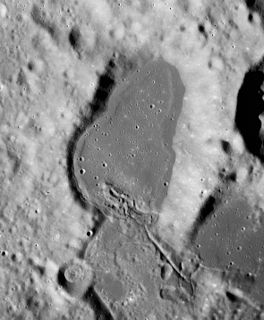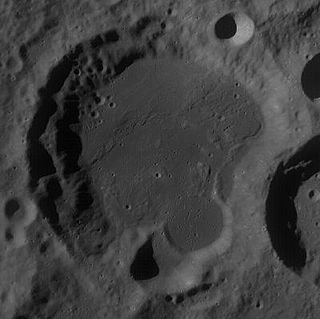 LRO WAC image | |
| Coordinates | 35°42′S128°24′W / 35.7°S 128.4°W Coordinates: 35°42′S128°24′W / 35.7°S 128.4°W |
|---|---|
| Diameter | 91 km |
| Depth | Unknown |
| Colongitude | 130° at sunrise |
| Eponym | Irving Langmuir |

Langmuir is an impact crater on the Moon's far side. It is located in a region to the southwest of the Mare Orientale impact basin. Langmuir is bracketed between two larger craters, with Chebyshev to the west-northwest and Brouwer to the east. It partly overlaps the rims of these two craters, making it the youngest of the three. The outer rampart of ejecta from Langmuir partly covers the southeast interior floor of Chebyshev.

An impact crater is an approximately circular depression in the surface of a planet, moon, or other solid body in the Solar System or elsewhere, formed by the hypervelocity impact of a smaller body. In contrast to volcanic craters, which result from explosion or internal collapse, impact craters typically have raised rims and floors that are lower in elevation than the surrounding terrain. Impact craters range from small, simple, bowl-shaped depressions to large, complex, multi-ringed impact basins. Meteor Crater is a well-known example of a small impact crater on Earth.

Earth's Moon is an astronomical body that orbits the planet and acts as its only permanent natural satellite. It is the fifth-largest satellite in the Solar System, and the largest among planetary satellites relative to the size of the planet that it orbits. The Moon is, after Jupiter's satellite Io, the second-densest satellite in the Solar System among those whose densities are known.

Mare Orientale is a lunar mare. It is located on the western border of the near side and far side of the Moon, and is difficult to see from an Earthbound perspective. Images from spacecraft have revealed it to be one of the most striking large scale lunar features, resembling a target ring bullseye.
This crater has not been heavily eroded, and many of its original features remain intact and sharply defined. The rim to the west is somewhat disrupted due to having overlaid the rim of the larger Chebyshev. In a coincidental arrangement, a small crater is situated across the rim edge at the northern end of where it joins with Chebyshev, and a smaller crater lies at the southern end of this merger.
The inner wall of Langmuir contains some minor terrace structures and displays some appearance of slumping along the southwestern edge. The inner wall in the southern half of the crater is wider than elsewhere, and is nearly twice as wide as the inner wall along the northern edge. As a result, the interior floor is offset to the north. There is a central peak formation on the floor, but it is located to the northeast of the midpoint. The floor is relatively level in the western half, but more uneven in the east.






















